Week 2 (Ch04)
Neuromotor Basis for Motor Control
2025-10-05
Presentation Viewing Recommendations
- This presentation is better viewed in a web browser, either on a computer or tablet. I do not recommend using mobile phones.
- Use keyboard shortcuts for navigation (e.g., arrow keys, spacebar).
- Use keyboard key “A” to pause/play audio on the current slide.
- The audio will automatically pause when you navigate to a different slide.
- Use keyboard key “S” for different viewing modes.
- If you issues with audio playback and captions, try a different web browser (e.g., Chrome, Firefox, Safari).
The PDF version of this presentation can be downloaded from the Download link at the top.
1 Objectives
- Describe the general structure of a neuron and the types and functions of neurons.
- Identify and describe the structural components of the brain that are most directly involved in control of movement and describe their primary functions.
- Identify and describe the neural pathways that make up the ascending and descending tracts.
- Describe a motor unit, the recruitment of motor units, and their relationship to the control of movement.
- Describe the basic components of a conceptual hierarchical model that describes the CNS structures and their functions in the control of movement.
Objective 1
Describe the general structure of a neuron and the types and functions of neurons.
Important
Intro Video: Take a few minutes to watch the intro video below on the neuron.
1.1 The Neuromotor System: An Introduction
- Start by watching this brief video on the nervous system: Nervous System Overview.
- The neuromotor system is the amazing foundation for how we control our movements, from simple to intricate tasks.
- This discussion will dive into the neurophysiological basis of actions, specifically the central nervous system’s (CNS) structure and function as it relates to motor skills.
- Understanding this process is vital for anyone planning a career in physical rehabilitation or helping people learn and relearn motor skills.
- It provides a comprehensive appreciation of human capabilities and limitations in movement.
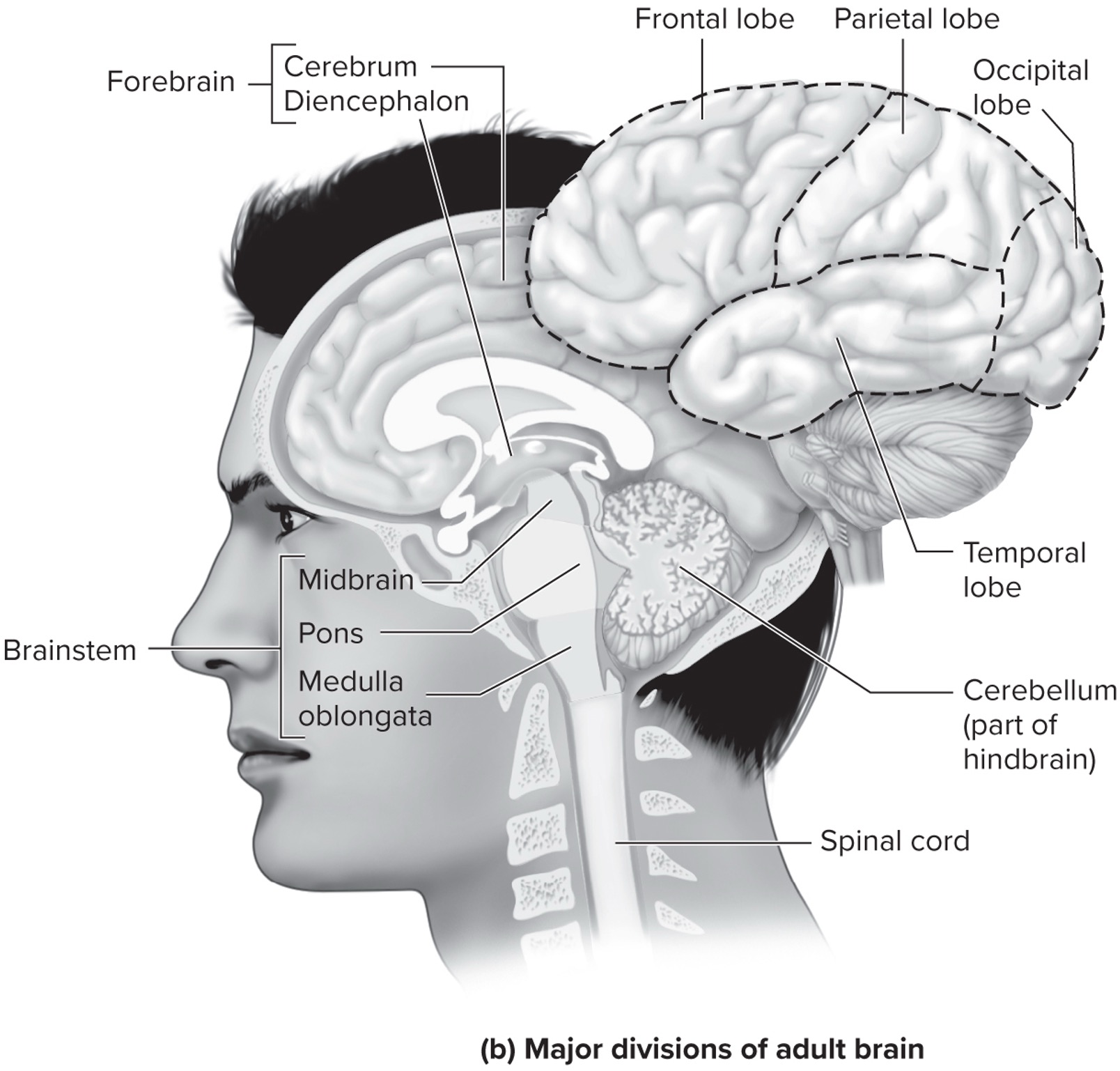
1.2 The Neuron: Basic Building Block
- NeuronsNerve cells; the basic component of the nervous system that provide the means for receiving and sending information through the entire nervous system. are billions of functional units essential for sending and receiving information throughout the nervous system.
- Most neurons share a similar general three-part structure:
- Cell body (soma): Contains the nucleus and organelles, vital for neuron function and homeostasis.
- DendritesExtensions from a neuron’s cell body that receive neural impulses from other neurons; a neuron may have none or as many as thousands of dendrites.: Tree-like branches primarily responsible for receiving signals from other neurons.
- AxonExtensions from a neuron’s cell body that transmit neural impulses to other neurons, structures in the CNS, or muscles; a neuron has only one axon, although most axons branch into many branches.: A long projection that transmits signals away from the cell body to other neurons, muscles, or glands.
- Many axons are covered by a myelin sheathA cellular membrane that speeds up the transmission of neural signals along the axon by acting as an electrical insulator., a fatty layer that acts as an electrical insulator and increases signal speed.
- Axon terminals: Serve as signal transmission relay stations for neurotransmittersChemical signals passed on to other neurons or to muscles in the specific case of movement control., which are chemical messengers.
- SynapseThe junction between the axon of a neuron and another neuron where the passing on of neural signals from one neuron to another occurs.: The specific junction where one neuron communicates with another.
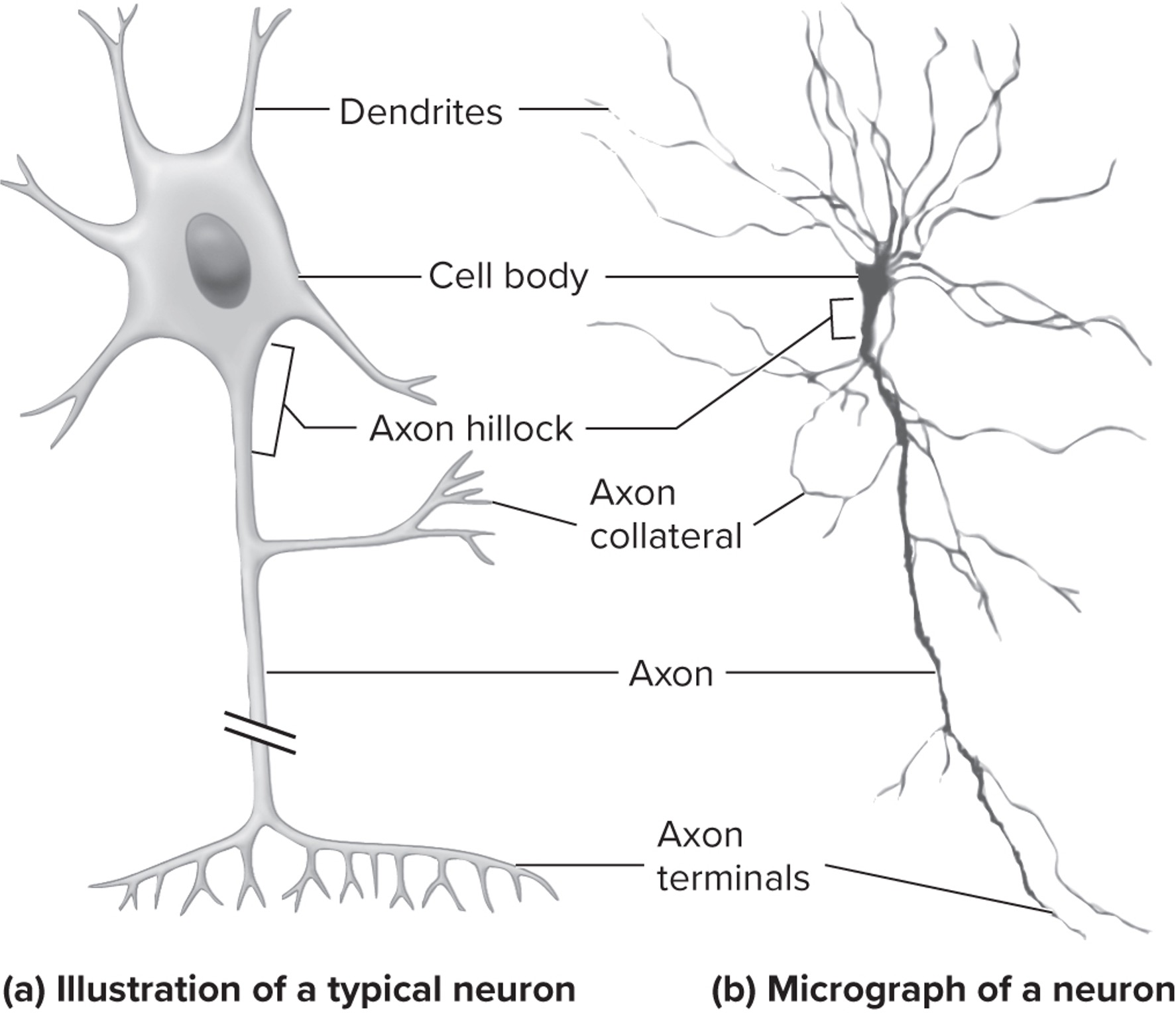
1.3 Neural Communication: The Electrochemical Process
- Neurons communicate through a fascinating electrochemical process.
- When sufficiently stimulated, a neuron generates an electrical impulse called an action potentialA rapid, all-or-nothing electrical signal that travels quickly down the axon once a threshold charge is reached..
- This rapid, all-or-nothing electrical signal travels quickly down the axon once a threshold charge is reached.
- At the axon terminals, the action potential triggers the release of neurotransmitters (chemical messengers stored in vesicles) into the synapse (the tiny gap between neurons).
- Neurotransmitters diffuse across the synapse and bind to specific receptors on the next (post-synaptic) neuron.
- This binding can either excite (making it more likely to fire) or inhibit (making it less likely to fire) the next neuron, ensuring precise information transmission.
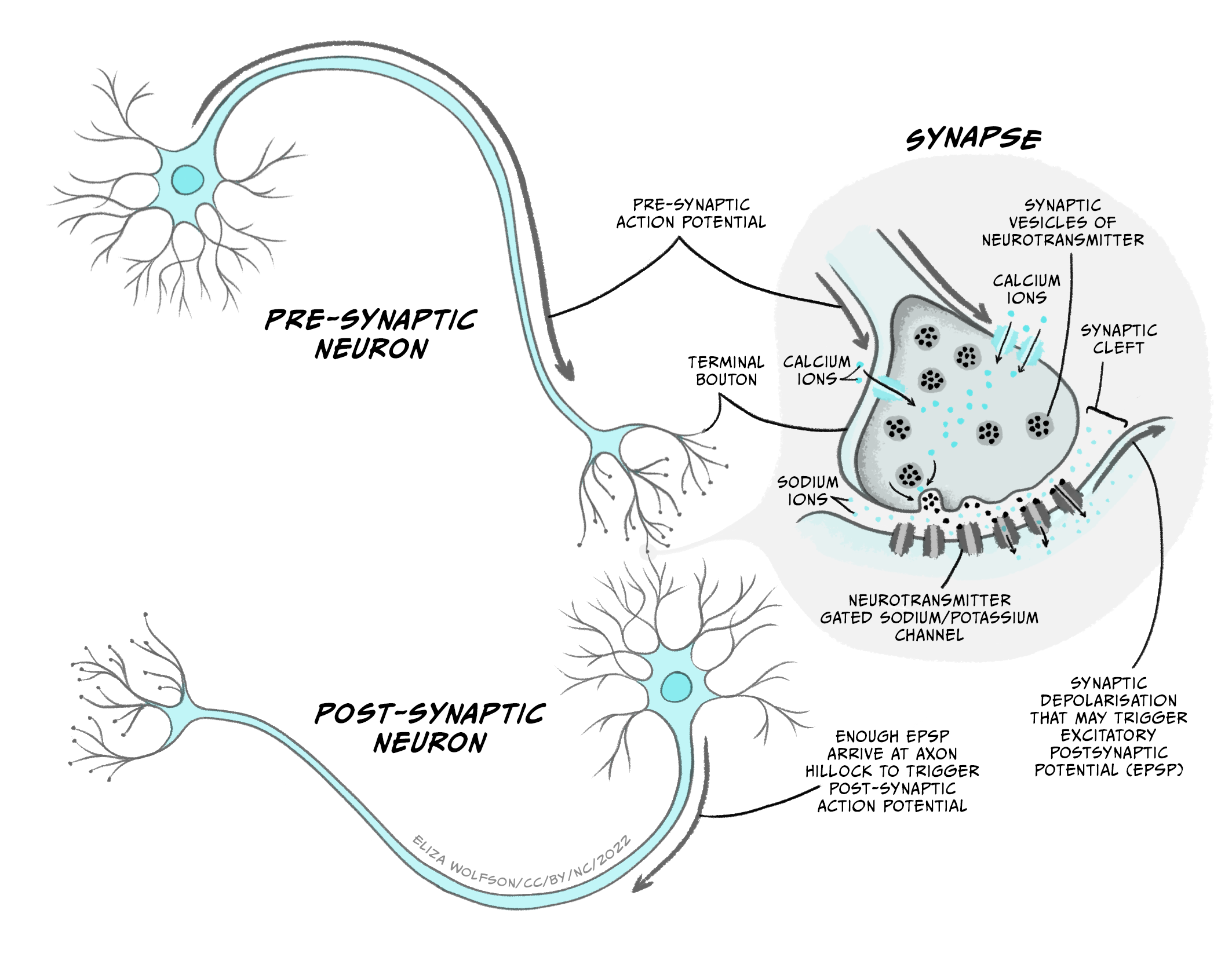
Image credit: https://doi.org/10.20919/ZDGF9829/5
1.4 Functional Classes of Neurons
- There are three main functional classes of neurons based on their role in the Central Nervous System (CNS)The central nervous system functions as the ‘command center’ for human behavior, comprising the brain and spinal cord, and forms the center of activity for the integration and organization of sensory and motor information.:
- 1. Sensory Neurons (Afferent NeuronsNerve cells that send neural impulses to the CNS. They receive information from sensory receptors and convert signals into electrical impulses. They are unipolar with one axon and no dendrites.):
- Send neural impulses to the CNS.
- Receive information from sensory receptors, converting signals into electrical impulses.
- Are unipolarHaving one axon and no dendrites; characteristic structure of sensory neurons. (one axon, no dendrites); cell body mostly in the peripheral nervous system.
- Helpful Tip: Afferent neurons Arrive at the CNS.
- 1. Sensory Neurons (Afferent NeuronsNerve cells that send neural impulses to the CNS. They receive information from sensory receptors and convert signals into electrical impulses. They are unipolar with one axon and no dendrites.):

1.5 Functional Classes of Neurons (continued)
- There are three main functional classes of neurons based on their role in the Central Nervous System (CNS):
- 2. Motor Neurons (Efferent NeuronsNerve cells that send neural impulses from the CNS to skeletal muscle fibers, crucial for movement control.):
- Send neural impulses from the CNS to skeletal muscle fibers, crucial for movement control.
- Alpha motor neuronsMotor neurons found predominantly in the spinal cord that connect directly with skeletal muscle fibers and serve as the functional unit of motor control.: Found mostly in the spinal cord, directly connect to skeletal muscle fibers.
- Gamma motor neurons: Supply intrafusal fibersSpecialized muscle fibers within skeletal muscles that are supplied by gamma motor neurons and are important for muscle spindle function. within skeletal muscles.
- Helpful Tip: Efferent neurons Exit the CNS.
- 2. Motor Neurons (Efferent NeuronsNerve cells that send neural impulses from the CNS to skeletal muscle fibers, crucial for movement control.):

1.6 Functional Classes of Neurons (continued)
- There are three main functional classes of neurons based on their role in the Central Nervous System (CNS):
- 3. InterneuronsSpecialized nerve cells that originate and terminate in the brain or spinal cord; they function between axons descending from the brain and synapse on motor neurons, and between the axons from sensory nerves and the spinal nerves ascending to the brain.:
- Function entirely within the CNS (brain or spinal cord).
- Act as connections between descending axons from the brain to motor neurons, and between sensory nerves and ascending spinal nerves.
- Critical for integrating signals within the CNS.
- Vastly numerous, with an estimated 200,000 interneurons for every sensory neuron.
- 3. InterneuronsSpecialized nerve cells that originate and terminate in the brain or spinal cord; they function between axons descending from the brain and synapse on motor neurons, and between the axons from sensory nerves and the spinal nerves ascending to the brain.:

1.7 StudyApp
I encourage you to stop and study the material just covered by visiting our StudyApp.
The StudyApp will open in a new window; once done, close and go back to the main presentation.
2 Objective Two
Identify and describe the structural components of the brain that are most directly involved in control of movement and describe their primary functions.
2.1 The Central Nervous System (CNS)
- The Central Nervous System (CNS) is an incredibly complex system comprising the brain and the spinal cord.
- It functions as the “command center” for human behavior.
- The CNS is the central hub for integrating and organizing all sensory and motor information that controls our movements.
- Our focus is on the specific CNS parts most directly related to motor control, especially voluntary, coordinated movement.
2.2 Major Structural Components of the Brain
- The brain’s major structural components most directly involved in controlling movement are:
- The Cerebrum
- The Diencephalon
- The Cerebellum
- The Brainstem
- The cerebrum and diencephalon are sometimes collectively referred to as the forebrain.
- Figure 4.3 illustrates these major divisions and their subcomponents, helping visualize their location within the brain.

Image credit: (Magill & Anderson, 2016)
2.3 The Cerebrum
- The cerebrumA brain structure in the forebrain that consists of two halves, known as the right and left cerebral hemispheres, connected by the corpus callosum. is divided into two halves: the right and left cerebral hemispheres.
- These hemispheres communicate via the corpus callosumA thick band of nerve fibers that connects the right and left cerebral hemispheres, allowing communication between them., a thick band of nerve fibers.
- The cerebral cortex is the distinctive undulating, wrinkly, gray-colored surface covering both hemispheres.
- It’s a thin tissue (2-5 mm thick) made up of nerve cell bodies, referred to as gray matter.
- Its folding creates gyriRidges formed by the folding of the cerebral cortex that increase its surface area. (ridges) and sulciGrooves formed by the folding of the cerebral cortex that increase its surface area. (grooves), vastly increasing its surface area.
- Cortical neurons are primarily pyramidal cellsPrimary cells for sending neural signals from the cortex to other parts of the CNS, named for the pyramid shape of their cell body., which send neural signals from the cortex to other CNS parts.
- Underneath the gray matter is white matter, an inner layer of myelinated nerve fibers that helps in rapid signal transmission.

Image credit: (Magill & Anderson, 2016)
2.4 Lobes of the Cerebral Cortex
- The cerebral cortex of each hemisphere is divided into four distinct lobes, named for the skull bones closest to them:
- The Frontal Lobe: Located at the front of the brain, anterior to the central sulcus. It is incredibly important for the control of voluntary movement, including planning and executing actions.
- The Parietal Lobe: Situated just behind the central fissure. It is a key brain center for perception and for integrating sensory information from different parts of the body.
- The Occipital Lobe: The most posterior lobe of the cortex. It contains areas vital for visual perception.
- The Temporal Lobe: Located just below the lateral fissure. It plays important roles in memory, abstract thought, and judgment.

Image credit: (Magill & Anderson, 2016)
2.5 Sensory Cortex and Association Areas
- Sensory Cortex Areas:
- Located posterior to the central sulcus, receiving specific types of sensory information via sensory nerves.
- Includes a somatic sensory area processing pain, temperature, and pressure from the body.
- Due to proximity and interconnectedness with motor areas, often referred to as the sensorimotor cortex.
- Association Areas:
- Crucial for higher-level processing, lying adjacent to specific sensory areas (parietal, temporal, occipital lobes).
- They “associate” or connect information from different sensory cortex areas, integrating various types of sensory input.
- Connect with other cortex regions for seamless interaction between perception and higher-order cognitive functions.
- Vital for complex decision-making related to movement, such as in choice reaction time situations.
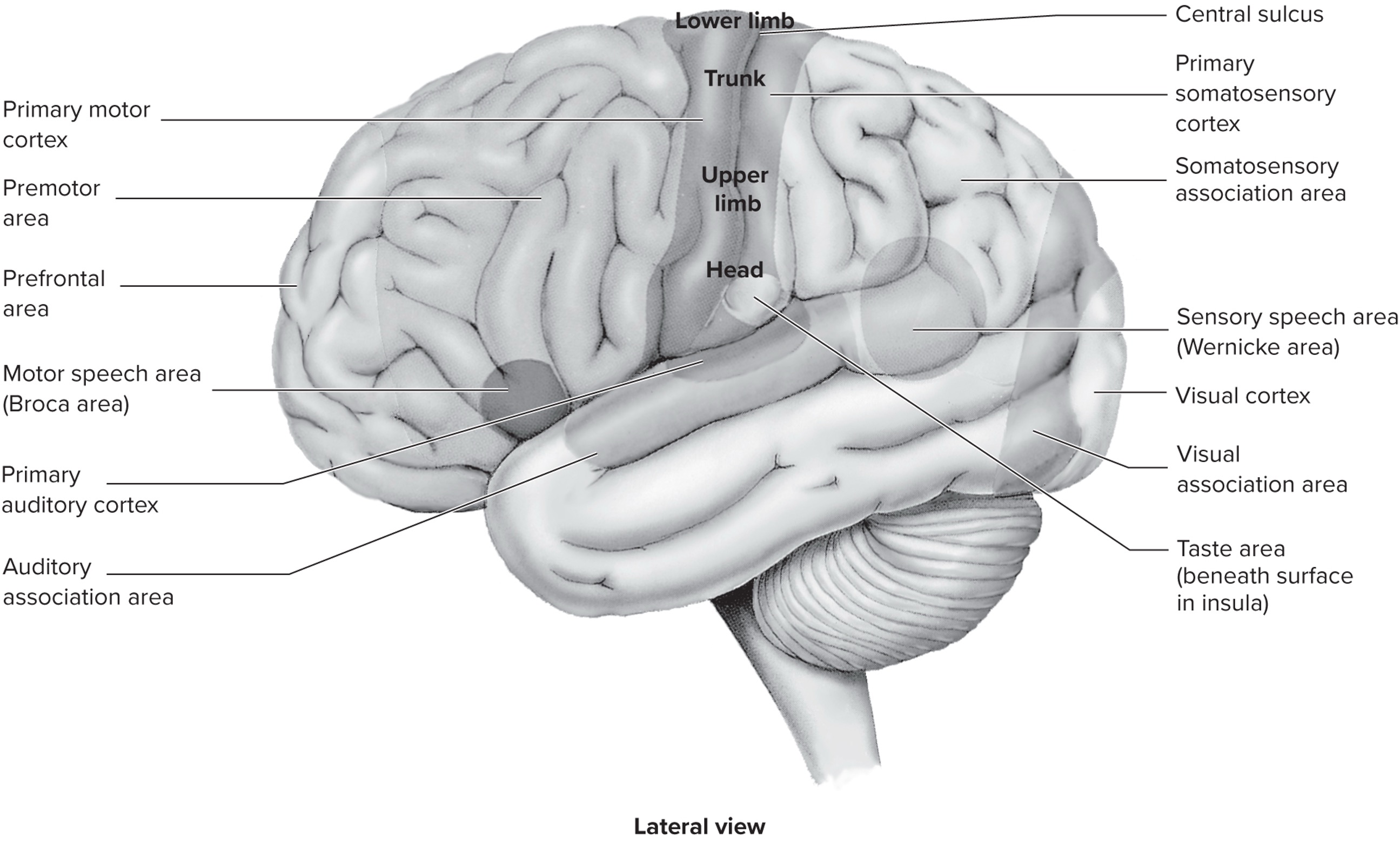
Image credit: (Magill & Anderson, 2016)
2.6 Motor Control Areas of the Cerebral Cortex
- Several areas within the cerebral cortex are particularly active in the control of movement:
- Primary Motor Cortex: Found in the frontal lobe, anterior to the central sulcus. Critical for initiating movements and coordinating fine motor skills (e.g., typing) and postural coordination.
- Premotor Area: Anterior to the primary motor cortex. Essential for organizing movements before they are initiated and maintaining rhythmic coordination during movement. Also plays a role in benefits from observing actions.
- Supplementary Motor Area (SMA): On the medial surface of the frontal lobe. Vital for controlling sequential movements and for the overall preparation and organization of movement.
- Parietal Lobe: A critical cortical area for voluntary movement control . Integrates movement preparation and execution processes by interacting with premotor cortex, primary motor cortex, and SMA before and during movement (e.g., visual attention, grasping).

Image credit: (Magill & Anderson, 2016)
2.7 Brain-Computer Interfaces (BCIs)
- Brain-Computer Interfaces (BCIs) offer incredible potential for individuals with neurological disorders who are unable to move physically .
- BCIs work by reading the electrical activity (brain waves) that occurs in the brain when a person imagines moving a body part .
- They can be part of an EEG skull cap or, in more advanced versions, implanted directly inside the brain .
- With training, BCIs can enable individuals to perform functional activities such as:
- Typing or manipulating small robots .
- Moving a cursor to communicate phrases.
- Maneuvering a prosthetic hand to grasp objects .
- Driving real and simulated wheelchairs .
- The success of BCI research demonstrates its strong potential to benefit a wide range of physical disabilities in the future.
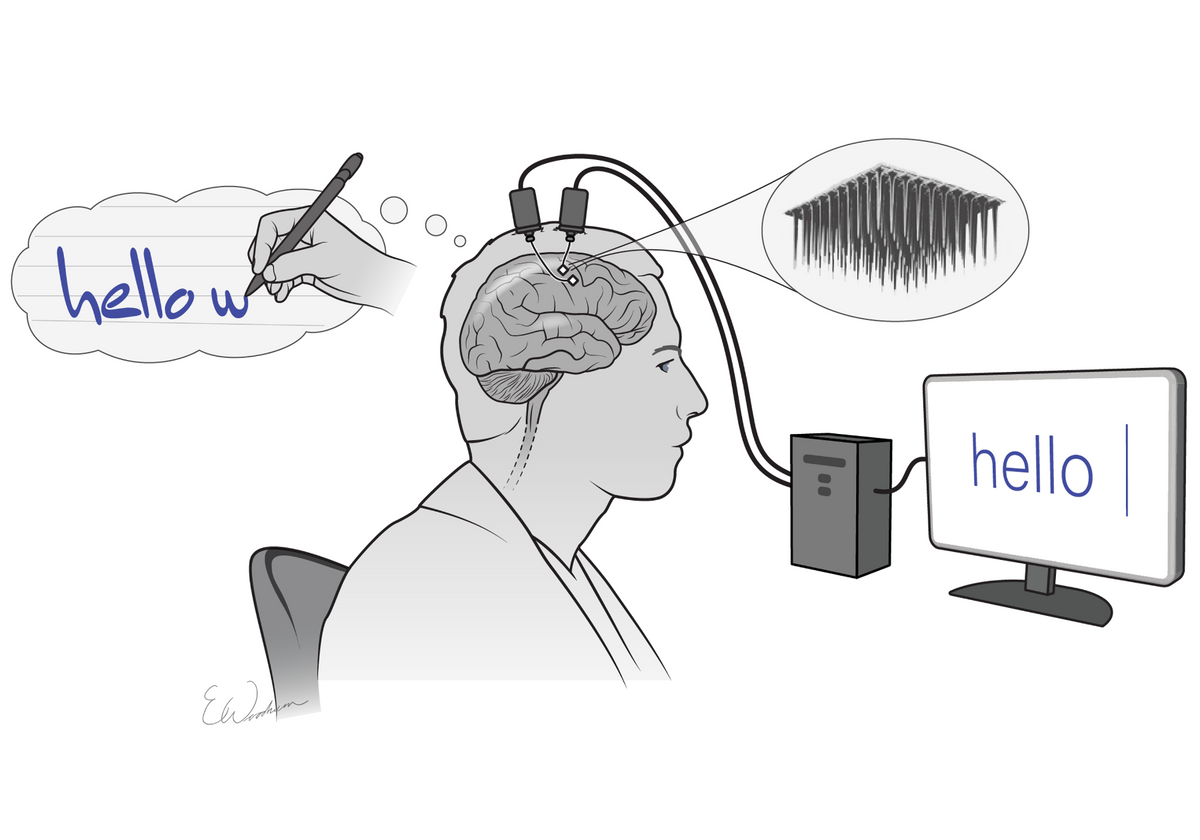
Image credit: https://bit.ly/4fQ9BVK
2.8 Subcortical Components: The Basal Ganglia
- The basal ganglia, also known as the basal nuclei, are collections of four large nuclei buried deep within the cerebral hemispheres: the caudate nucleus, the putamen, the substantia nigra, and the globus pallidus.
- They receive neural information from the cerebral cortex and brainstem, with motor neural output primarily to the brainstem.
- The basal ganglia play critical roles in the planning and initiation of movement, the control of antagonist muscles during movement, and the control of force.
- Much is known about their role from studying Parkinson’s diseaseA basal ganglia disorder caused by a lack of dopamine production due to degeneration of neurons in the substantia nigra, leading to bradykinesia (slow movements), akinesia (reduced movement), tremor, and muscular rigidity., a basal ganglia disorder caused by a lack of dopamine production due to degeneration of neurons in the substantia nigra.
- This leads to movement difficulties including bradykinesiaSlow movements, a characteristic symptom of Parkinson’s disease resulting from basal ganglia dysfunction. (slow movements), akinesiaReduced amount of movement, a characteristic symptom of Parkinson’s disease resulting from basal ganglia dysfunction. (reduced movement), tremor, and muscular rigidity.
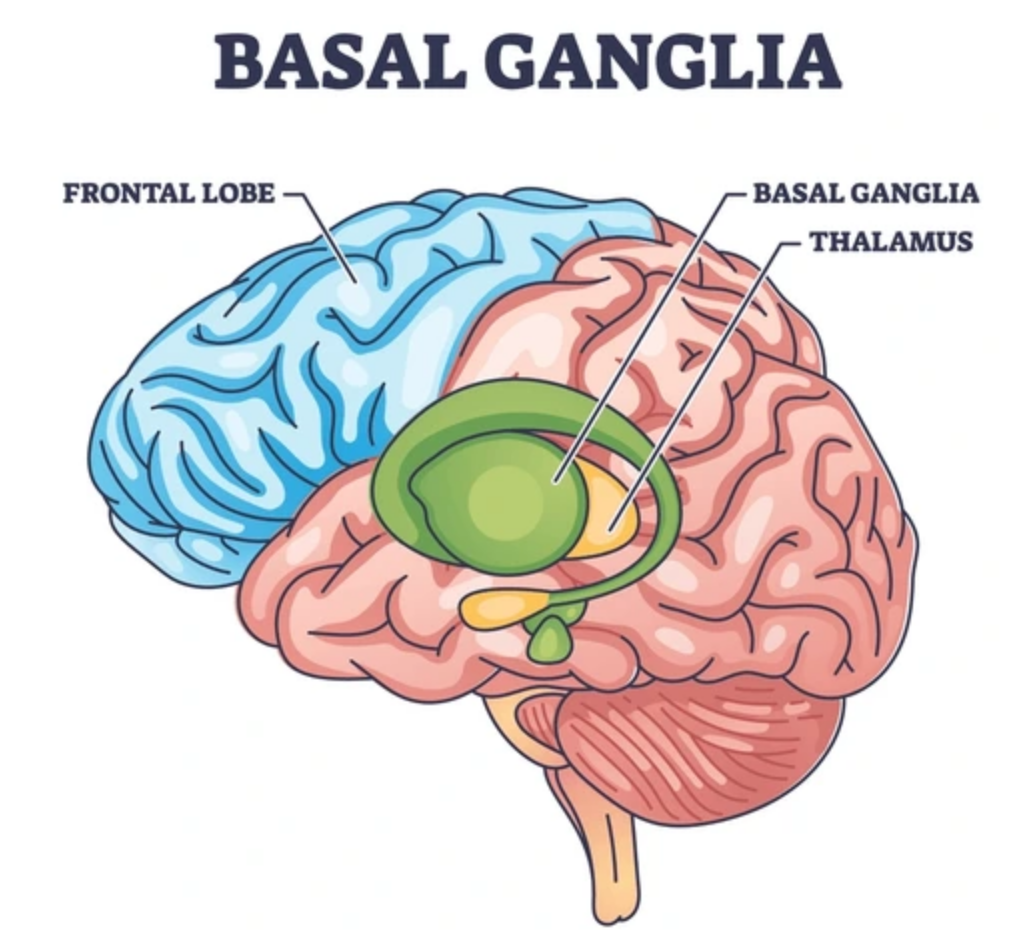
2.9 Subcortical Components: The Diencephalon
- The diencephalon is strategically located between the cerebrum and the brainstem .
- It contains two important groups of nuclei :
- The ThalamusA crucial relay station that receives and integrates most sensory neural inputs from the spinal cord and brainstem, then passes this information to the cerebral cortex. Also plays a significant role in controlling attention, mood, and pain perception.:
- Acts as a crucial relay station .
- Receives and integrates most sensory neural inputs from the spinal cord and brainstem, then passes this information to the cerebral cortex .
- Also plays a significant role in controlling attention, mood, and pain perception .
- The HypothalamusArguably the most critical brain center for controlling the endocrine system (hormone system), regulating overall body homeostasis including body temperature, hunger, thirst, and physiological responses to stress.:
- Arguably the most critical brain center for controlling the endocrine system (hormone system) .
- Regulates overall body homeostasis, including body temperature, hunger, thirst, and physiological responses to stress.
- The ThalamusA crucial relay station that receives and integrates most sensory neural inputs from the spinal cord and brainstem, then passes this information to the cerebral cortex. Also plays a significant role in controlling attention, mood, and pain perception.:

2.10 The Cerebellum
- The cerebellum is located behind the cerebral hemispheres and directly attached to the brainstem.
- It is covered by the cerebellar cortex (divided into two hemispheres) and contains deep cerebellar nuclei.
- It receives sensory neural pathways from the spinal cord, cerebral cortex, and brainstem.
- Its motor neural pathways connect to the spinal cord and send output to the motor cortex via the thalamus (cerebello-thalamo-cortico pathway).
- The cerebellum plays a key role in the execution of smooth and accurate movements; damage often results in clumsy movements.
- A major function is as a movement error detection and correction system :
- Receives an “efference copyA copy of intended movement signals that the cerebellum receives to compare with sensory information and signal needed adjustments to movements in progress.” of intended movement signals.
- Compares this with sensory information to signal needed adjustments to movements in progress.
- It is also active in eye-hand coordination, movement timing, force control, and posture.
- Critically involved in the learning of motor skills through interaction with the cerebral cortex.
2.11 The Brainstem
- The brainstem is located directly under the cerebral hemispheres and connects to the spinal cord.
- It contains three main areas involved in motor control :
- Pons: Located at the top, acts as a “bridge” between the cerebral cortex and the cerebellum. Influences chewing, swallowing, salivating, breathing, and balance.
- Medulla (Medulla Oblongata): An extension of the spinal cord. Regulates crucial internal physiological processes like respiration and heartbeat. It is a critical site where sensory and motor corticospinal tracts cross over the body’s midline, meaning one side of the brain controls movements on the opposite side.
- Reticular Formation: A complex network of nuclei and nerve fibers, serving as a vital link between sensory receptors and motor control centers. Its primary role is as an integrator of sensory and motor neural impulses, influencing CNS activity to affect skeletal muscle.

2.12 The Limbic System
- Start by watching this brief video overview of the limbic system: Limbic System Overview.
- The limbic system is not a single structure but an important group of interconnected brain structures.
- It includes parts of the frontal and temporal lobes of the cerebral cortex, as well as the thalamus and hypothalamus, and connecting nerve fibers.
- While often associated with emotions and visceral behaviors, the limbic system also plays important roles in the learning of motor skills.
- This highlights how various brain regions work together to support movement and learning, even those not traditionally thought of as “motor” centers.
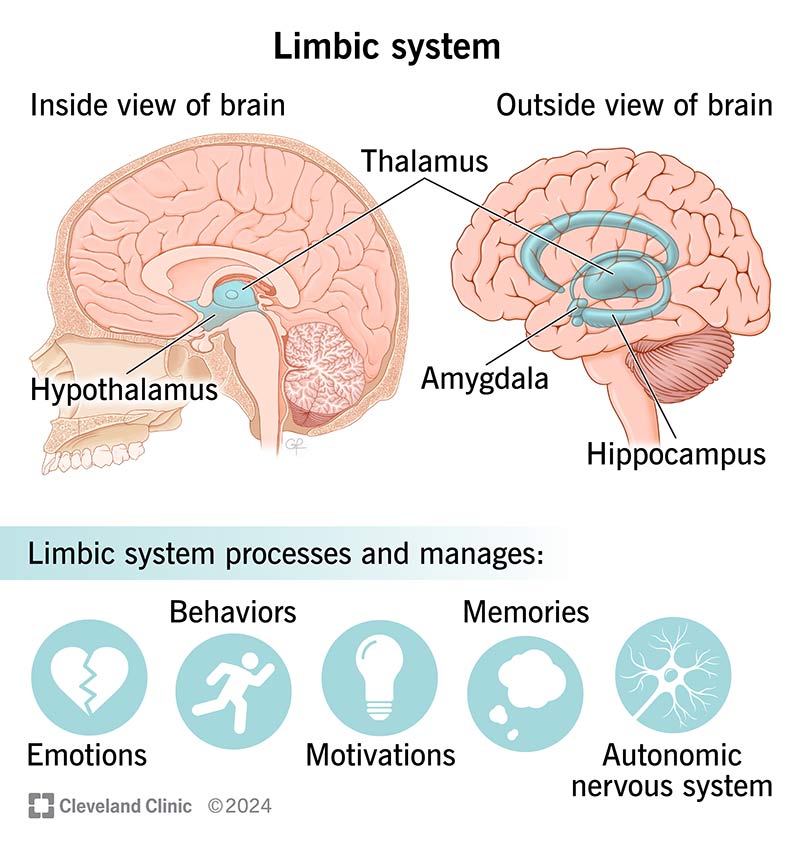
2.13 StudyApp
I encourage you to stop and study the material just covered by visiting our StudyApp.
The StudyApp will open in a new window; once done, close and go back to the main presentation.
3 Objective Three
Identify and describe the neural pathways that make up the ascending and descending tracts
3.1 The Spinal Cord
- The spinal cord is a complex system critically involved in motor control processes and interacts with other systems.
- It is primarily composed of gray matter and white matter.
- The gray matter forms a distinctive butterfly- or H-shape in the central portion:
- Dorsal horns (posterior pair): Contain cells involved in transmitting sensory information from sensory neurons.
- Ventral horns (anterior pair): Contain cell bodies of alpha motor neurons, whose axons terminate on skeletal muscles to initiate movement.
- Also contains interneurons (e.g., Renshaw cells) that can inhibit alpha motor neuron activity.
- The spinal cord also has dorsal and ventral roots where nerves enter and exit, forming spinal nerves.
- It is encased within a vertebra for protection.
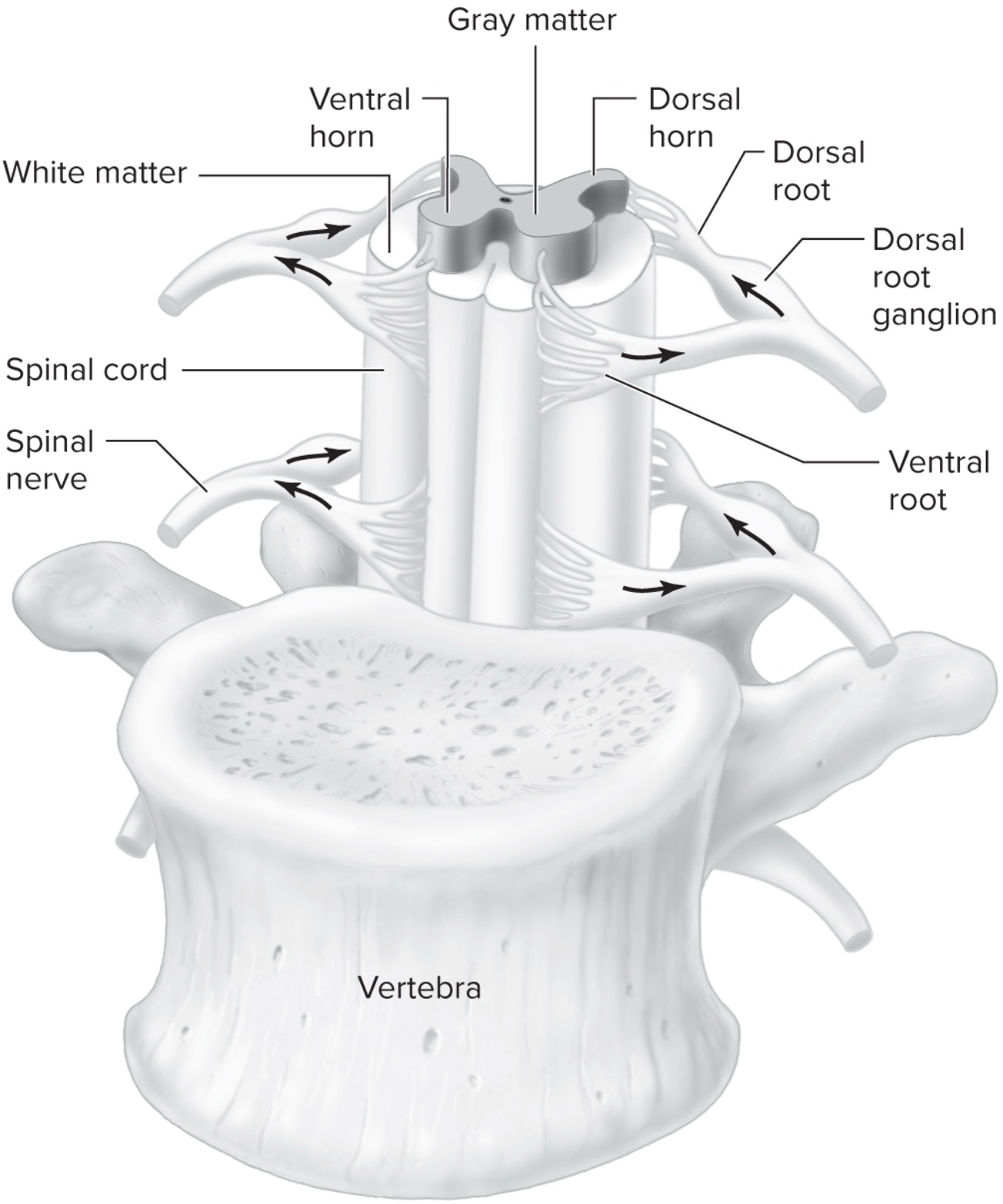
3.2 Spinal Cord Pathways: Ascending (Sensory) Tracts
- Sensory neural pathways, also known as ascending tractsSensory neural pathways in the spinal cord and brainstem that connect with the various sensory areas of the cerebral cortex and cerebellum., transmit neural information from the body to the brain.
- They pass through the spinal cord and brainstem, connecting with sensory areas of the cerebral cortex and cerebellum.
- These tracts are specialized to carry signals from specific types of sensory receptors (e.g., proprioceptionThe sense of body position and movement in space, providing information about where body parts are located relative to each other and the environment., touch, pain).
- Two important ascending tracts for voluntary movement control are:
- The Dorsal Column: Primarily carries information about proprioception, touch, and pressure.
- The Anterolateral System: Transmits pain and temperature information, along with some touch and pressure.
- Both the dorsal column and anterolateral system tracts enter the thalamus before continuing to the cerebral cortex.
- Spinocerebellar tractsAscending tracts that are crucial for transmitting proprioception information specifically to the cerebellum. are crucial for transmitting proprioception information specifically to the cerebellum.
- Most ascending tracts cross over at the brainstem (decussateTo cross over from one side of the body to the other, as nerve fibers do at the brainstem.), meaning sensory information from the right side of your body is processed in the left side of your brain, and vice versa.
3.3 Spinal Cord Pathways: Descending (Motor) Tracts
- Motor neural pathways, called descending tractsMotor neural pathways that descend from the brain through the spinal cord., originate in the brain and descend through the spinal cord.
- They are classified into two main groups that work together to control movement:
- Pyramidal Tract (Corticospinal Tract)Motor pathways that originate in various parts of the cerebral cortex (60% from the primary motor cortex) and primarily transmit information for the control of fine motor skills. Most fibers cross over to the opposite side of the body at the medulla.:
- Originates in various parts of the cerebral cortex (60% from the primary motor cortex).
- Most fibers cross over (decussate) to the opposite side of the body at the medulla in the brainstem.
- Primarily transmits information for the control of fine motor skills, like precise finger movements.
- Extrapyramidal Tracts (Brainstem Pathways):
- Have cell bodies in the brainstem, with axons descending into the spinal cord.
- Most fibers do not cross over to the opposite side of the body.
- Mainly involved in postural control and facilitating or inhibiting hand and finger flexion/extension muscles.
- Pyramidal Tract (Corticospinal Tract)Motor pathways that originate in various parts of the cerebral cortex (60% from the primary motor cortex) and primarily transmit information for the control of fine motor skills. Most fibers cross over to the opposite side of the body at the medulla.:
3.4 StudyApp
I encourage you to stop and study the material just covered by visiting our StudyApp.
The StudyApp will open in a new window; once done, close and go back to the main presentation.
4 Objective Four
Describe a motor unit, the recruitment of motor units, and their relationship to the control of movement
4.1 The Motor Unit
- The motor unitThe alpha motor neuron and all the muscle fibers it innervates; it serves as the functional unit of motor control for the innervation of the muscles involved in a movement. is defined as the alpha motor neuron and all the muscle fibers it innervates.
- It is the functional unit of motor control for innervating muscles involved in a movement.
- The connection between the alpha motor neuron and skeletal muscle fibers occurs at a specialized synapse called the neuromuscular junctionA specialized type of synapse located near the middle of muscle fibers that allows nerve impulses to be transmitted from the nerve fiber to the muscle fibers so that appropriate muscle contraction can occur., located near the middle of the muscle fibers.
- This synapse allows nerve impulses to be transmitted directly to muscle fibers, causing them to contract.
- The number of muscle fibers served by one alpha motor neuron varies significantly:
- For fine movements (e.g., eye, larynx), a motor unit may innervate very few muscle fibers (sometimes just one).
- For large skeletal muscles involved in gross motor skills or posture, one motor unit can innervate a large number (up to 700).
- When an alpha motor neuron activates, all the muscle fibers it connects to will contract simultaneously.
4.2 Motor Unit Recruitment and Force Control
- The amount of force a muscle exerts is controlled by motor unit recruitment.
- The number of active muscle fibers directly influences the amount of force produced.
- To increase force, the nervous system increases the number of motor units activated.
- This process follows the Henneman size principleThe recruitment process that begins with the smallest, and therefore the weakest, motor units and systematically progresses to the largest, which are the most powerful motor units. Named after the initial reporting of this process by Henneman (1957).:
- Recruitment begins with the smallest (weakest) motor units.
- It systematically progresses to the largest (most powerful) motor units as more force is required.
- This systematic activation allows for precise and graded control over muscle force, whether for a gentle or heavy task.
4.3 StudyApp
I encourage you to stop and study the material just covered by visiting our StudyApp.
The StudyApp will open in a new window; once done, close and go back to the main presentation.
5 Objective Five
Describe the basic components of a conceptual hierarchical model that describes the CNS structures and their functions in the control of movement.
5.1 Neural Control of Voluntary Movement: A Hierarchical View
- Performing any motor skill begins with a cognitively derived intent.
- This intent is implemented into movement through a complex interplay of neurophysiological events and the cooperative interaction of many CNS structures and the peripheral nervous system.
- This interaction occurs both hierarchically and in parallel.
- The conceptual motor control hierarchy has three levels:
- 1. Highest Level (“Higher Centers”): Responsible for forming complex plans based on intention. Includes areas for memory, emotions, supplementary motor area, and association cortex, integrating input from many brain structures.
- 2. Middle Level: Converts high-level plans into smaller motor programs that determine neural activation patterns and subprograms for individual joint movements. Involves the sensorimotor cortex, cerebellum, parts of the basal nuclei, and some brainstem nuclei.
- 3. Lowest Level (“Local Level”): Executes specific details, specifying muscle tension and joint angles at precise times. Structures are the brainstem or spinal cord levels where motor neurons exit.
- This intricate, multi-level interaction underlies even the simplest behavioral activities.
5.2 Cognitive Intent and Neural Activity
- Brain activity is influenced not just by the type of movement, but also by the cognitive intent behind the movement.
- Different patterns of activity can occur in the CNS even when the same movement pattern is used to achieve different action goals.
- For example, research with pianists showed distinct neural activity for the same finger flexion movement:
- When the goal was synchronization with an auditory beat: Activation in contralateral sensorimotor cortex, supplementary motor area (SMA), and ipsilateral cerebellum.
- When the goal was syncopation (off the beat): Additional brain areas were activated, including the premotor, prefrontal, and temporal association areas, along with the basal ganglia.
- This highlights how the brain dynamically adapts its network activity based on the subtle nuances of our intentions.
5.3 Practical Implications for Practitioners
- Understanding the neuromotor system has practical implications for future practitioners:
- 1. Clear Instructions: Since action intent is critical, ensure clients have a clear understanding of what they are supposed to do. Clear communication significantly impacts skill performance.
- 2. Know Damage Location: For clients with neurological dysfunction, knowing the specific location of damage in their nervous system provides a comprehensive understanding of their capabilities and limitations in movement, allowing for tailored approaches.
- 3. Check Medication: If clients are taking medication for neurological dysfunction, always check that they have taken their most recent dose before rehabilitation sessions, as medication effectiveness impacts performance and participation.
- Applying these insights enables more effective and informed support for clients.
5.4 StudyApp
I encourage you to stop and study the material just covered by visiting our StudyApp.
The StudyApp will open in a new window; once done, close and go back to the main presentation.
References
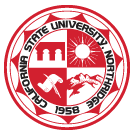
Download | Ovande Furtado Jr., Ph.D. | CSUN | KIN Department | KIN479 Motor Control | Course Site